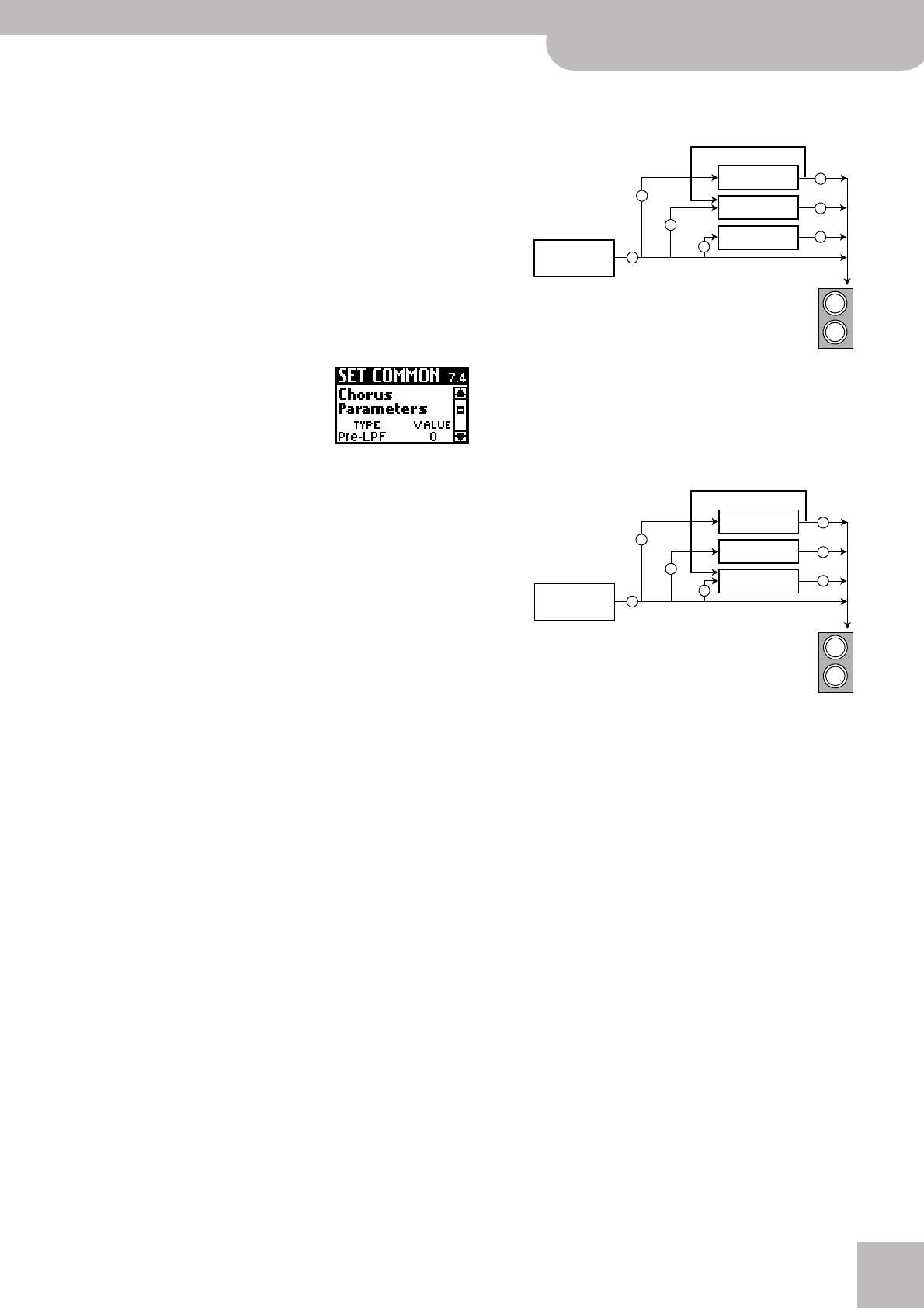
7.4 Chorus Parameters
V-Accordion
r
57
The important thing to remember here is that the
overall chorus volume depends on three things: the
Send level of the various sections, the output level of
the Chorus processor and the setting of the
[CHORUS] knob.
If one of them is set to “0”, there will be no chorus. If
the Send level of a section (the BASS section, for
example) is set to “0”, only that section will have no
chorus. Other sections (whose Send value is different
from “0”), however, can still be processed by the Cho-
rus effect. If the LEVEL parameter on this page is set
to “0”, the Chorus processor is effectively off for all
sections.
7.4 Chorus Parameters
This page contains several
parameters that need to be
selected using the TYPE entry.
Be sure to first select the
parameter you want to change
and then set its value.
(1) If necessary, press the [DATA÷ENTER] knob to select
the “TYPE” parameter, then rotate the
[DATA÷ENTER] knob to select a parameter.
■ Pre-LPF (0~7)—A low-pass filter can be applied to the
high-frequency range before the signals coming from the
various sections are processed by the chorus. Higher values
make the Send signals darker, resulting in a mellower cho-
rus sound. Note that this parameter only applies to the sig-
nals that are sent to the Chorus processor. It does not alter
the sound of the active sections.
■ Level (0~127)—This parameter sets the output volume
of the Chorus processor. It is linked to its namesake on the
“7.3 Chorus Macro Type” page. Higher values result in a
more prominent Chorus effect.
■ Feedback (0~127)—This parameter sets the level at
which the Chorus sound is re-input (fed back) into the
Chorus. By using Feedback, a denser Chorus sound can be
created. Higher values result in a greater feedback level.
■ Delay (0~127)—This parameter sets the delay of the
Chorus effect. Higher values will cause greater deviation in
pitch of the chorus sound.
■ Rate (0~127)—This parameter sets the speed (fre-
quency) at which the chorus sound is modulated. Higher
values result in faster modulation.
■ Depth (0~127)—This parameter sets the depth at which
the chorus sound is modulated. Higher values result in a
more pronounced modulation.
■ Chr® Rev (0~127)—This parameter sets the amount of
chorus sound that is sent to the Reverb processor. The
value “127” effectively allows you to connect the Chorus
and Reverb effects in series (Chorus before Reverb). If you
do not want the chorus signal to be processed by the
Reverb effect, set this value to “0”.
■ Chr®Dly (0~127)—This parameter sets the amount of
chorus sound that is sent to the Delay processor. Higher
values result in more sound being sent. The value “127”
effectively allows you to connect the Chorus and Delay
effects in series (Chorus before Delay). If you do not want
the chorus signal to be processed by the Delay effect, set
this value to “0”.
(2) Press the [DATA÷ENTER] knob to select the “VALUE”
parameter, then rotate the [DATA÷ENTER] knob to
set the value (see the indications between brackets
above).
If you change one of the above parameter values, an
“(E)” appears next to the “TYPE” name to signal that
you are no longer using the presets of the macro in
question.
If you then select another TYPE, however, your
changes are lost and replaced by the settings of the
newly selected macro.
Note: Simultaneously press the [UP] and [DOWN] buttons to
recall the factory setting for the currently active parameter.
Chorus
Level
Volume
Chorus
Send
Reverb
Send
Delay
Send
Level
Level
Reverb
Delay
L
R
Section
STEREO OUTPUT
sockets
(e.g. Treble)
Chorus
Level
Volume
Chorus
Send
Reverb
Send
Delay
Send
Level
Level
Reverb
Delay
L
R
Section
STEREO OUTPUT
sockets
(e.g. Treble)


















